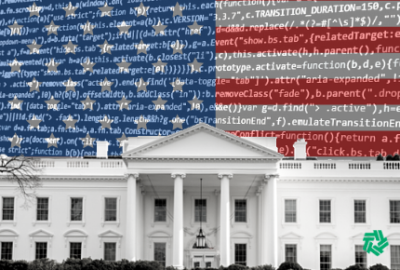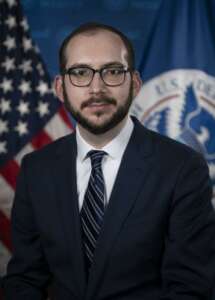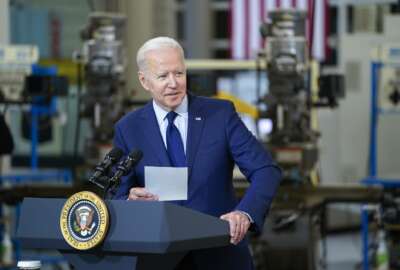

The Technology Modernization Fund board is ensuring agency proposals are tied to investment and overall strategic plans.
Agencies submitted just under 100 proposals to get a share of the $1 billion in the Technology Modernization Fund.
This was about the number Federal Chief Information Officer Clare Martorana was hoping for back in May.
While more specific details about the proposals, including which agencies and for what kind of projects remain hush-hush—I’m told the Office of Management and Budget is planning to brief lawmakers in the coming weeks about the TMF progress—some details have started to trickle out.
Eric Hysen, the Department of Homeland Security’s CIO, said his agency submitted four proposals to obtain TMF funding.

“I am regularly talking with my colleagues at OMB and the General Services Administration about and advocating for those projects through the process,” Hysen said at the Acquisition Trends conference sponsored by the Professional Services Council. “Those include work to modernize how we process non-citizens arriving at the southern border and better exchange data across DHS components and other agencies; looking at the travel process and as travel picks up again after the pandemic, how we can make the experience of going through an airport easier, more seamless and more secure; looking at how some of our components access and analyze key data sets in conjunction with our new chief data officer; and also how we share critical threat information with our state and local law enforcement partners, which is only more important as we look to confront the threats presented by domestic violence and extremism.”
Matt Hartman, the deputy executive assistant director for cybersecurity at the Cybersecurity and Infrastructure Security Agency at DHS and a TMF board member, said the board already reviewed three agency proposals to move toward a zero trust architecture.
“With the new minimal repayment model in place, this is really a good vehicle for agencies to jump start some of these really critical capabilities,” Hartman said at a recent event sponsored by Meritalk. “I know that OMB, GSA and others are really focused on security in this next iteration of the TMF.”
The scarcity of information about the number of proposals or the agencies which applied isn’t surprising.
House staff members say OMB has yet to schedule briefings with key committees. OMB briefed lawmakers in April ahead of the TMF guidance the administration released in early May.
An aide to Sen. Maggie Hassan (D-N.H.) said the chairwoman of the Homeland Security and Governmental Affairs Subcommittee on emerging threats and spending oversight is pleased to see agencies taking advantage of the TMF.
“[She] hopes that the TMF Board prioritizes proposals that dispose of costly and inefficient legacy IT systems,” the aide added.
Rep. Gerry Connolly (D-Va.), chairman of the Oversight and Reform Subcommittee on government operations, said at the MITRE event he is focused on making sure agencies have clear guidance for how to apply for TMF funding, and those plans are monitored to address any potential challenges.
He said the subcommittee will monitor OMB and agency use of TMF funding.
OMB has the opportunity to reverse four years of subpar communication with lawmakers about the value and benefits of the TMF. It’s understandable why Martorana and staff don’t want to get ahead of Congress, but they also shouldn’t lose site of the importance of telling TMF’s story to as many people as possible.
And there should be plenty to say with just under 100 proposals. OMB promised agencies to accelerate the review of proposals sent in by June 2 for this first tranche of funding.
The board added new alternate members to help review proposals, including Maria Roat, the deputy federal CIO, Chris DeRusha, the federal chief information security officer, Harrison Smith, the co-director of the Enterprise Digitalization and Case Management at the IRS, Sheena Burrell, the deputy CIO of the National Archives and Records Administration, and Sean Connelly, the Trusted Internet Connections Program Manager at CISA.
Roat, who spoke last week at an event sponsored by MITRE, said the board received proposals from a range of agencies, including the Department of Defense for the first time.
“With the TMF proposals, we are connecting the dots, tying the investments to overarching strategic plans, mission requirements and outcomes as well as we are considering agency budget submissions, looking at fiscal 2022 and 2023,” she said. “We need to make sure we maintain the quality, governance and rigor that made all the prior awarded projects successful. As expected, we are seeing large scale modernization, cybersecurity projects that require multi-year and sustained continuous investments. I’m really excited by the number of projects and the ability to prioritize those projects that cut across agencies, address those security gaps and improve the public’s ability to access public services.”
The fact that DoD applied for TMF funding demonstrates how the changes to the repayment incentive as well as the surge in funding is making the TMF more attractive. That was especially true for DHS.
“As we are looking at all of these efforts and the long list that we are still working on below that, we are looking at this in a way that is a little different from how DHS at least viewed the TMF in the past,” Hysen said. “You will note, I didn’t name any components or any systems or programs in the examples I just gave. I talked about common needs and uses across the department. What we are trying to do very deliberately is not just use the TMF as an opportunity to look at our big list of unfunded modernization programs that we just need one vendor and we already have a whole plan for. But really to look at common problems and challenges across the department and set up systems and structures that will allow us to move together. We think we can get a lot more done if we modernize in common aligned ways across DHS components and systems.”
He said the goal isn’t to build one system for the entire agency, but focus on systems that will serve the customer better and using the TMF funding to move forward together across the department.
Hysen said he expects that DHS will continue to submit proposals to obtain TMF funding in the coming months.
Roat said the TMF board and project management office already started reviewing project proposals.
OMB should consider publicizing details sooner than later given House members have begun marking up the fiscal 2022 financial services and general government spending bill. Lawmakers included “only” $50 million for the TMF next year. This is well below the White House’s request of $500 million.
The good news about the initial bill is the Office of Personnel Management would receive authorization to develop an IT working capital fund, which is the more valuable piece of the Modernizing Government Technology Act. The MGT Act also created the TMF.
OPM could transfer up to 3% of unspent salaries and expenses funding into the working capital fund for IT modernization efforts.
If this provision makes it into law, OPM would be the second agency, joining SBA, to receive approval from Congress for the IT working capital fund.
Over the long run, OPM or any other agency may not need Congressional approval—which has been difficult to obtain.
Hassan has promised to introduce a technical amendment to clarify that agencies do not need new authority from Congress to create the WCF.
The aide to Hassan said she is continuing to work on a fix to the Modernizing Government Technology Act, and our team is having ongoing discussions with Rep. Connolly’s office about addressing the issues with working capital funds.
At the MITRE event, Connolly said plans to fix the MGT Act issue with working capital funds either through legislation or meetings with agency general counsels.
“We will have to work with the Appropriations Committee because this becomes a bit of a turf battle in terms of what can you do with appropriated dollars and who has jurisdiction over that,” he said. “It’s just critical that every agency has a working capital fund so that they can stay abreast of changes in technology, that they can implement the latest encryption programs and measures to protect the assets in the databases and the proprietary information, and retire those legacy systems. I see that as another critical piece in addition to the TMF.”
Copyright © 2025 Federal News Network. All rights reserved. This website is not intended for users located within the European Economic Area.
Jason Miller is executive editor of Federal News Network and directs news coverage on the people, policy and programs of the federal government.
Follow @jmillerWFED



